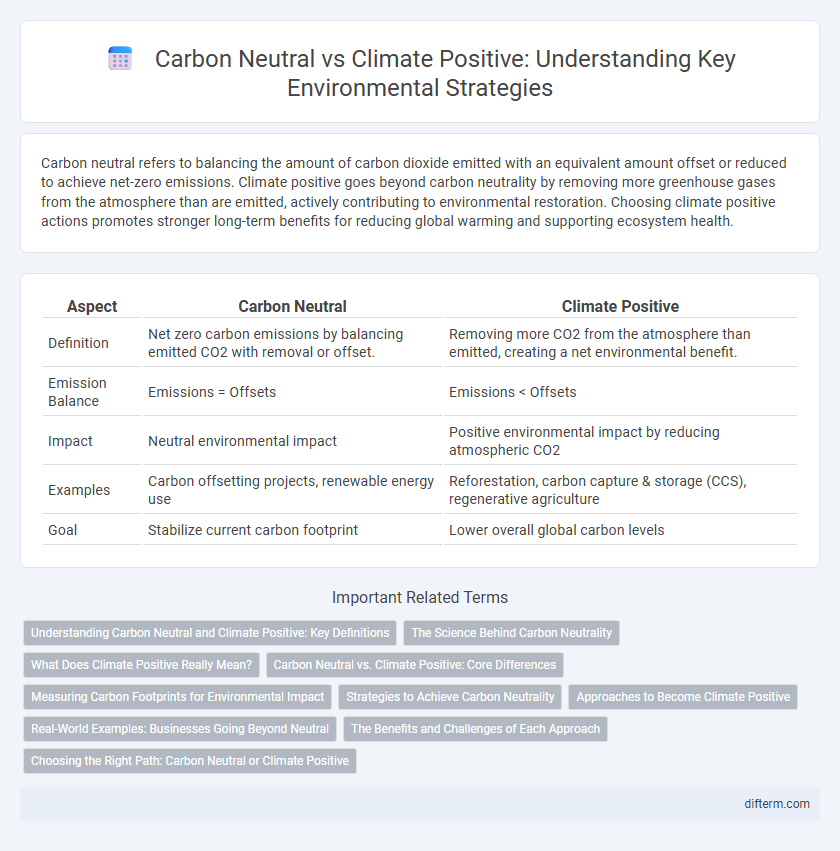Carbon neutral refers to balancing the amount of carbon dioxide emitted with an equivalent amount offset or reduced to achieve net-zero emissions. Climate positive goes beyond carbon neutrality by removing more greenhouse gases from the atmosphere than are emitted, actively contributing to environmental restoration. Choosing climate positive actions promotes stronger long-term benefits for reducing global warming and supporting ecosystem health.
Table of Comparison
| Aspect | Carbon Neutral | Climate Positive |
|---|---|---|
| Definition | Net zero carbon emissions by balancing emitted CO2 with removal or offset. | Removing more CO2 from the atmosphere than emitted, creating a net environmental benefit. |
| Emission Balance | Emissions = Offsets | Emissions < Offsets |
| Impact | Neutral environmental impact | Positive environmental impact by reducing atmospheric CO2 |
| Examples | Carbon offsetting projects, renewable energy use | Reforestation, carbon capture & storage (CCS), regenerative agriculture |
| Goal | Stabilize current carbon footprint | Lower overall global carbon levels |
Understanding Carbon Neutral and Climate Positive: Key Definitions
Carbon neutral refers to balancing the amount of carbon dioxide emitted with an equivalent amount sequestered or offset, resulting in net-zero carbon emissions. Climate positive goes beyond neutrality by actively removing additional greenhouse gases from the atmosphere or preventing emissions elsewhere, creating a net environmental benefit. Understanding these definitions is crucial for organizations aiming to reduce their carbon footprint and contribute to global climate goals.
The Science Behind Carbon Neutrality
Carbon neutrality involves balancing emitted carbon dioxide with an equivalent amount sequestered or offset, aiming for net-zero emissions based on verified greenhouse gas accounting standards like the GHG Protocol. In contrast, climate-positive actions go beyond net-zero by actively reducing atmospheric CO2 through methods such as increased carbon sequestration in forests and soil or investing in renewable energy projects that generate surplus environmental benefits. The scientific foundation relies on accurately measuring carbon fluxes, lifecycle emissions analysis, and implementing robust carbon offset projects to ensure genuine environmental impact.
What Does Climate Positive Really Mean?
Climate positive refers to actions or initiatives that go beyond achieving net-zero carbon emissions by actively removing additional carbon dioxide from the atmosphere, thereby creating a net environmental benefit. Unlike carbon neutral efforts that balance emissions with offsets, climate positive strategies invest in regenerative projects such as reforestation or carbon capture technologies that reduce overall greenhouse gases. This proactive approach contributes to reversing climate change, supporting biodiversity, and fostering sustainable ecosystems.
Carbon Neutral vs. Climate Positive: Core Differences
Carbon neutral refers to balancing emitted carbon dioxide with equivalent carbon removal or offsetting, effectively achieving net-zero emissions. Climate positive goes beyond carbon neutrality by reducing more greenhouse gases than are emitted, resulting in a net positive impact on the environment. The core difference lies in climate positive efforts actively improving ecological health, while carbon neutral practices aim only to neutralize environmental damage.
Measuring Carbon Footprints for Environmental Impact
Measuring carbon footprints involves quantifying greenhouse gas emissions from activities, serving as a baseline for both carbon neutral and climate positive strategies. Carbon neutral initiatives balance emissions with equivalent carbon reduction or offset efforts to achieve net-zero impact. Climate positive approaches go beyond neutrality by actively removing additional carbon, resulting in a net environmental benefit.
Strategies to Achieve Carbon Neutrality
Implementing renewable energy sources such as wind, solar, and hydropower significantly reduces carbon emissions, driving progress toward carbon neutrality. Enhancing energy efficiency in buildings, transportation, and industry minimizes overall energy consumption, crucial for cutting greenhouse gases. Carbon offset initiatives, including reforestation and carbon capture technologies, balance remaining emissions, ultimately supporting the transition from carbon neutral to climate positive outcomes.
Approaches to Become Climate Positive
Approaches to become climate positive involve reducing greenhouse gas emissions beyond achieving carbon neutrality by actively removing or offsetting more carbon dioxide than generated. Strategies include investing in renewable energy projects, enhancing carbon sequestration through reforestation and soil management, and supporting innovative technologies such as direct air capture. Companies and organizations adopt comprehensive lifecycle assessments and implement circular economy principles to minimize emissions while generating negative net carbon footprints.
Real-World Examples: Businesses Going Beyond Neutral
Patagonia exemplifies climate-positive initiatives by not only achieving carbon neutrality but also investing in reforestation projects that absorb more CO2 than their total emissions. Interface, a global carpet manufacturer, has implemented regenerative practices that restore ecosystems and reduce carbon footprints beyond net-zero emissions. These businesses demonstrate effective strategies where climate positive efforts surpass carbon neutrality, showcasing practical models for sustainable corporate responsibility.
The Benefits and Challenges of Each Approach
Carbon neutral efforts focus on balancing emitted carbon dioxide with equivalent removals, reducing the overall carbon footprint, which helps mitigate climate change by stabilizing greenhouse gas levels. Climate positive strategies go beyond neutrality by removing additional emissions from the atmosphere, enhancing biodiversity, and promoting renewable energy adoption, but they require substantial investment and careful verification to ensure net positive impacts. Both approaches contribute essential benefits to global sustainability goals, while facing challenges such as measurement accuracy, regulatory support, and scalability.
Choosing the Right Path: Carbon Neutral or Climate Positive
Choosing between carbon neutral and climate positive approaches depends on organizational goals and environmental commitment. Carbon neutral efforts aim to balance emitted greenhouse gases by reducing or offsetting emissions, while climate positive strategies go beyond neutrality by actively removing more carbon from the atmosphere than is emitted. Embracing climate positive initiatives can enhance sustainability impact, foster innovation, and improve brand reputation in the evolving environmental landscape.
carbon neutral vs climate positive Infographic

 difterm.com
difterm.com